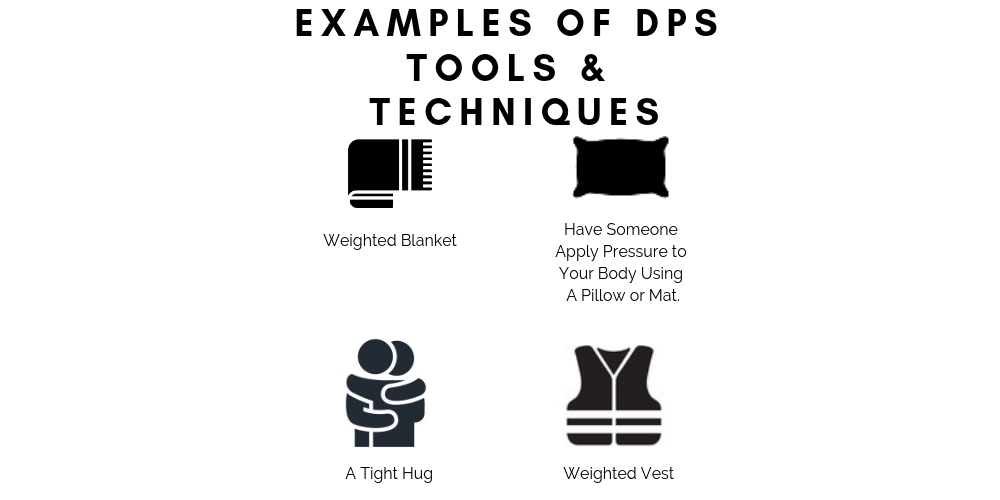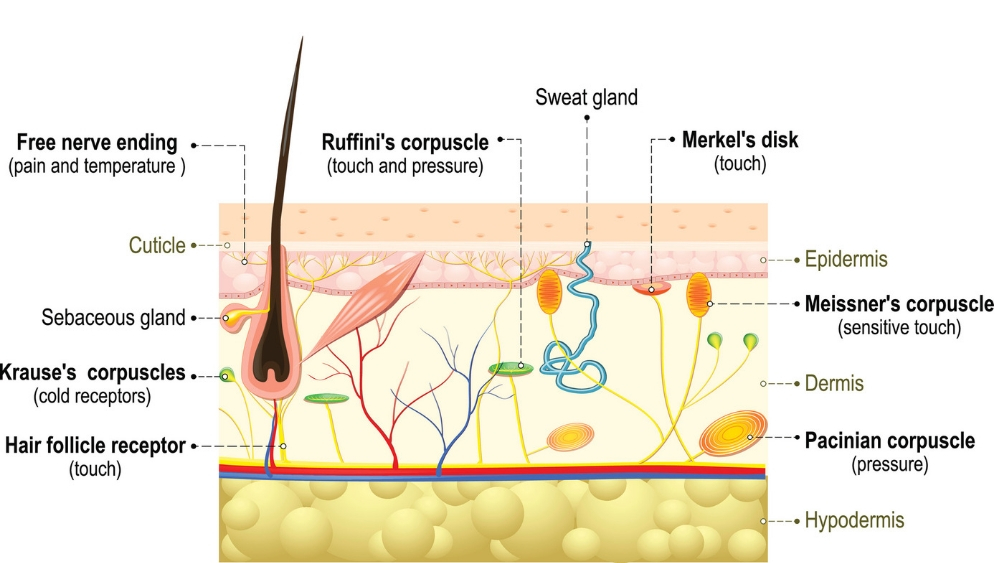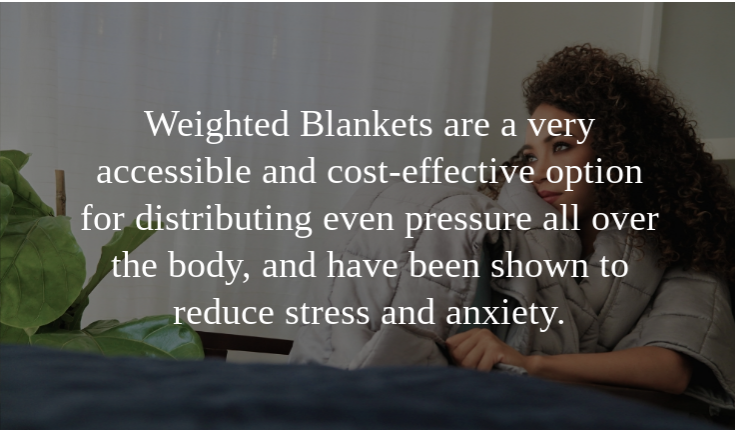Whether you call them weighted blankets, heavy blankets, or gravity blankets, they are blankets that weigh a bit more than your average throw. Weighted blankets and various other pressure-applying tools have been used in occupational therapy settings for decades. Recently, these blankets have become popular, and with merit, as they have known mental health benefits. What is less known is why weighted blankets work so well.
The concept of weighted blankets started with Dr. Temple Grandin, who was one of the founders of this pressure application, also known as deep pressure touch. Dr. Grandin worked as an animal scientist and noticed that cows appeared to be calmer after going through a shoot which applied pressure to their bodies. From this observation, she studied how deep pressure touch could be used with people who had extreme anxiety as a symptom of autism spectrum disorder. Dr. Grandin was also diagnosed with autism, so this was an issue for which she had personal ties. Now, the concept of deep pressure touch has become popularized and incorporated into easy-to-use interventions such as weighted blankets, which allows people to reduce anxiety at home.
From research and the previous experience of those around us, we know that deep pressure touch tools such as weighted blankets do have the ability to reduce anxiety, but how?
Defining Deep Pressure Touch
Before diving into the science behind weighted blankets, we must first recognize the overarching term that can be used to describe the concept behind weighted blankets. The mechanism of action behind weighted blankets is commonly referred to as deep pressure touch or deep pressure stimulation. Regardless of your wording preference, this concept is responsible for creating the calm feeling we get when there is heaviness against our skin.
Weighted blankets are not the only deep pressure touch option on the market. Standard tools also used in therapeutic settings include weighted vests, compression shirts, or Temple Grandin’s Hug Machine. In times when weighted vests and weighted blankets were not available, occupational therapists became creative and implemented a “gym mat sandwich” technique. This technique applies pressure to a person using mats. Service dogs are also being taught the skill of deep pressure touch by laying on their owner when their owner shows signs of anxiety. In sum, deep pressure touch tactics have been studied for decades, and are just now receiving the attention it deserves in the form of weighted blankets.

Weighted blankets are receiving more attention than other forms of deep pressure touch due to their versatile nature and on-demand therapeutic benefits. One can wrap the blanket around their shoulders, drape it over their lap, or wrap their entire body to obtain desired pressure. Healthy adults report waking up refreshed and relaxed after using a weighted blanket during the night continuously.
So we know that weighted blankets are popular and make us feel good, but why? What is it that makes us feel calmer when we are cocooned in their grasp?
What happens when weighted blankets touch our skin?
Let’s break this down. What is the first part of your body to touch and respond to the weighted blanket? Your skin. Everyone’s skin is equipped with receptors that react to different feelings. For example, you would feel pain if someone abruptly grabbed your arm, you would feel tickled if someone lightly touches your arm, and you would feel secure and safe if someone holds your arm in a gentle but firm way. We respond differently depending on the amount of pressure applied against our skin.

Weighted blankets tap into the concept of “feel-good pressure” by applying the right amount of pressure against the skin to elicit the feeling of a hug. After the pressure is applied to your skin, the sensation follows a nerve pathway leading to your brain. Then, your brain decides how to interpret/ react to the feeling.
What happens to the body and brain with weighted blankets?
The autonomic nervous system is situated within your brain and consists of two parts: the sympathetic nervous system and the parasympathetic nervous system. When you perceive danger or feel anxious, the sympathetic nervous system kicks in; it is our fight or flight response to threats. When our sympathetic nervous system is activated, our body adjusts processes to face the perceived threat such as increase the heart rate, dilate the pupils, and allow for more oxygen to reach the muscles.
Our body essentially gets excited to fight or flee the situation, but when someone feels anxiety, there often is no real danger, the emotion is typically brought on by nonexistent fears. When one has chronic stress, they are more likely to live with heightened sympathetic nervous system activity, which can wreak havoc on one’s health and caused a shorter lifespan.
The parasympathetic nervous system does the opposite of the sympathetic nervous system. Its job is to heighten the body’s ability to “rest and digest,” so the parasympathetic nervous system lowers the heart rate, relaxes the muscles, allows for slow, steady breathing, and returns pupils to normal. Heightened parasympathetic activity is our ideal state want to be in –cool as a cucumber. Our body performs at optimally with more parasympathetic nervous system activity.
How does this relate to weighted blankets? Well, when a weighted blanket is applied, sympathetic nervous system activity is reduced, and parasympathetic nervous system activity is heightened. Basically, the pressure tricks the body into believing it is safe, and therefore, the body doesn’t respond to the danger-based thoughts. One may think to themselves, “oh my gosh, what if I don’t nail this job interview tomorrow?!” However, the body is not going to respond to that thought, and thus, you won’t experience the physical symptoms associated with anxiety.
The physical symptoms are what prolongs anxiety; thoughts are much easier to dispute when there aren’t bodily sensations taking place that are associated with the ideas.
How quickly will my weighted blanket work?
The great thing about the body is, it’s quick. Though these processes seem daunting, you can rest assured that steps A- Z occur pretty quick. Champagne, Mullen, Dickson, & Krishnamurty (2015) found that healthy adults experienced a reduction in symptoms of anxiety in just 5-minutes. Note that everyone is different, and some people may need a bit more time to feel the effects, but this isn’t an intervention that takes hours to work. Pretty cool, huh?
Weighted Blankets as a tool for mental health

The culmination of all these processes creates the perfect storm for anxiety relief. Weighted blankets provide people with a relatively easy coping skill that can be used just about anywhere.
This is fantastic news because mental health is tough. When you break your arm, you go to the doctor and get a cast. Your arm will heal naturally, without any thought. With mental health ailments, one needs to work at thought-stopping continually and thought shifting to make long-lasting changes, and this can be exhausting. In the meantime, while changes are slowly occurring, consumers can seek comfort in their weighted blanket and obtain (almost) instantaneous relief.
Check out our website at truhugs.com to learn more about the science behind how weighted blankets work.
About the Author
Veronica is a Clinical Psychology Ph.D candidate who specializes in mindfulness meditation research. She has sought out holistic remedies for her clients and recently has dissected deep pressure stimulation research to further understand how weighted blankets can alleviate symptoms felt by her client. Read more about her findings at Truhugs.com.


